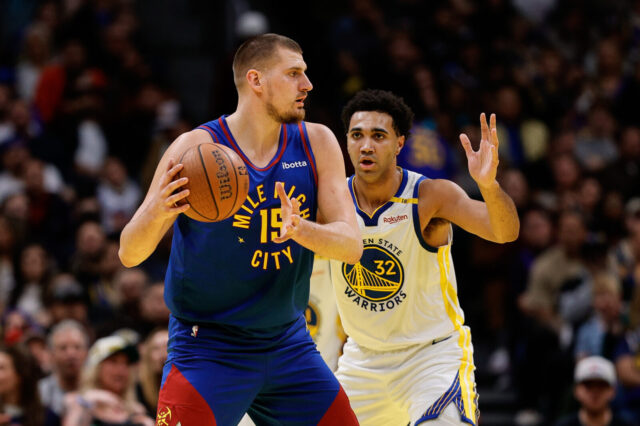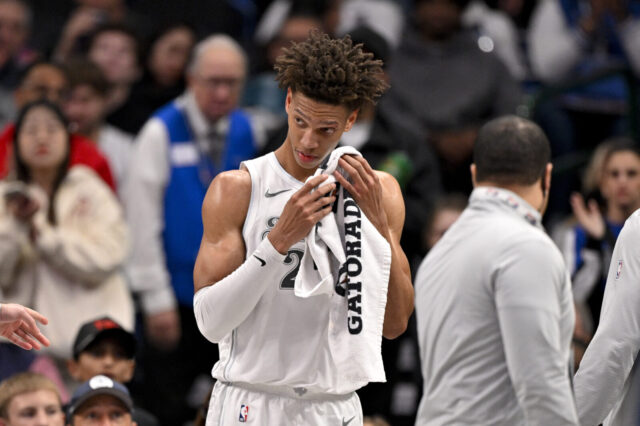One of the joys of Denver’s offense is that they rely quite heavily on their front court players to do things that are typically reserved for wings and guards. Nikola Jokic has been called a point center, as has his understudy, Mason Plumlee. There is a herky-jerky style to Paul Millsap’s game that sometimes looks awkward or off-rhythm but that disguises a very fundamental skill set that includes the ability to handle the ball, pass on the move, and orchestrate the offense from every spot on the court.
Trey Lyles is 6’10” and possesses many of the traits required to be a skilled big. He has a good handle that he uses to gain a step on his defender before often turning and placing that defender on his hip, combining a face-up move with a post move like the one below. These are some of the best types of moves for Lyles because they combine his two best attributes: speed and size. The face-up move allows Lyles to use his speed to get to his spot and the post move allows Lyles to use his size to create that final bit of separation.
But while Lyles has a nice one-on-one game, he can make an enormous leap as a player by improving his decision-making and body control as the ball-handler in the pick-and-roll (PnR). The Denver Nuggets offense is a free-flowing offense which, at it’s best, creates opportunities for all four players surrounding Jokic (or Plumlee) to act as the ball-handler coming off of a PnR or dribble handoff (DHO). The effectiveness of the offense is often predicated on the team’s ability to transition from one PnR to another, often in quick succession. If one PnR doesn’t work, quickly move the ball across the court for another. And then another. And another. Until eventually the team has caught the defense out of position and is able to take advantage.
Through the first three games of the season, Lyles has struggled to make the right read as the ball-handler in this position. He has twice as many turnovers as he does assists and is shooting just 28% form the field. Part of this is that he just hasn’t found himself in the positions he is most comfortable in: spot up shooting, posting up, and in transition. But one of the main reasons he has struggled is because he has made some indecisive reads in the PnR.
In the clip below, the screen between Lyles and Plumlee yields a very favorable start, as the two defenders elect to switch the screen, placing the lumbering rookie, DeAndre Ayton on Lyles and the more slender-bodied Ryan Anderson on Plumlee. Both players are handed an advantage but Lyles gets into trouble when he puts his head down and attacks the paint at one speed, ultimately plowing into Anderson and getting called for the charge.
Lyles just needs to read the defense a bit quicker. Plumlee immediately gains a rebounding advantage on Anderson as soon as the players switch so Lyles should identify the spot the defense is in and wait for Plumlee to grab position for an offensive rebound. He should also anticipate how the Suns defense will become extra concerned with helping Ayton contain Lyles. As the ball gets below the foul line, Devin Booker sags off of his man on the strong side and Mikal Bridges completely abandons his man on the weak side.
This is something he can anticipate and the quicker he reads that, the more he will realize that he doesn’t need to explode towards the basket, he can instead setup the possession by reading which of the defenders is going to overhelp. In this case, all three do, and Lyles should’ve been able to drop off the pass to either Plumlee, Malik Beasley, or Juancho Hernangomez.
Here’s another example in which the defense elects to drop the big man rather than switch. The play begins similar to the previous example, with Lyles receiving the DHO and then reversing back toward his left. And similar to the last example, Lyles allows himself to get sped up rather than simply reacting to the defense.
Tyson Chandler is trying to defend both Plumlee and Lyles at the same time by dropping back and preventing Lyles from getting close to the rim. Lyles’ best bet is to try and force Chandler to pick one or the other by either attacking his feet and going hard at the rim knowing that if Chandler contests the shot, Plumlee is in great position for the rebound. Another option is to keep the on-ball defender on his hip for a split second so that Plumlee can roll to the rim, a technique known as keeping your defender in jail.
Instead, he allows Chandler to wall off all good options and settles for a mid-range jumper that is blocked from behind.
In the final example, Lyles is given a huge cushion to fire off from behind the three-point line but Lyles once again seems determined to put his head down and attack the rim.
Lyles does a lot of great things on the offensive end and can be a matchup nightmare for opposing teams even without navigating the PnR like a 10-year veteran. However, his longterm value on the Nuggets will skyrocket if he can become a more reliable option in these situations. If he can slow the game down when coming off of the screen in plays like the ones above, then the rest of his skillset will start to flourish and he can start to climb out of his mini slump.


